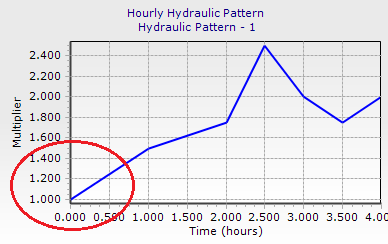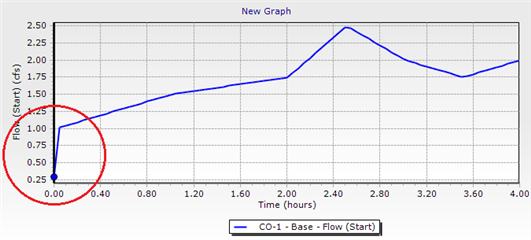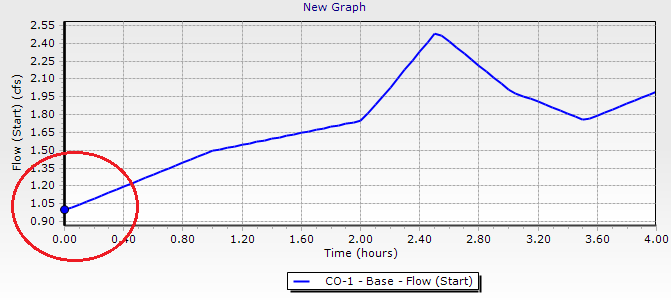| Product(s): |
SewerGEMS, CivilStorm |
| Version(s): |
CONNECT Edition, V8i |
| Area: |
Calculations |
Problem
When using the Implicit Dynamic solver in SewerGEMS or CivilStorm, the flow in a conduit at the start of the simulation is lower than expected, for example when compared to the multipliers used in a pattern load.

Expected pattern from inflow load:

Resulting observed conduit flow, with decreased flow at simulation start:

Solution
This is likely due to attenuation effects as the initially dry pipe fills with water at the start of the simulation. (by default pipes are assumed to be dry at the start of the simulation) So, the correct amount of water volume is entering the pipe, but the hydrograph is attenuated due to the storage space and travel time in the pipe. You may find this effect more pronounced for certain pipe and structure diameters and slopes.
The Start Type calculation option could be used in this case to adjust the assumptions that the numerical solver makes, for the initial hydraulics. See more about that here: Transition Start vs. Warm Start for the Implicit solver calculation options
Warm Start used:

Flow at end of simulation does not match time zero even though loading pattern multipliers are the same
Even when using the Warm Start option, if you are looking at the flow at a downstream point in the network at the end of the simulation, it may not match the flow at the beginning of the simulation even if loading pattern multipliers are the same at the beginning and end, because of attenuation effects that happen later on in the simulation. Meaning, the warm start will not perform a complete calculation of the entire simulation before time zero, so it would not be able to estimate attenuated effects from later on.
For example consider a pipe downstream of 100 manholes with sanitary loads that use a pattern with multiplier of 1.0 at hour 0, 1.0 at hour 24, and a peak in the middle. If the model is computed for 24 hours, the flow at hour 24 may be higher than the flow at hour zero even with the warm start option, because the storage effects of the pipe network result in an attenuated hydrograph as the peak flow recedes at hour 24. There would be no way to estimate this raised starting flow without a complete 24 hour run before the simulation starts, so the flow at time zero is essentially an estimate that is typically acceptable for most modeling cases.
If you have a situation where you need to compare model results to field measurements (flow monitoring), consider running the model for twice as long (for the pattern to repeat), then overlay your field measurements starting at the end of the first half of the simulation. The Chart Options in a graph can be used to adjust the bottom axis starting position, if needed.
See Also
Transition Start vs. Warm Start for the Implicit solver calculation options
Unexpected decrease in flow is seen between two pressure pipes in series